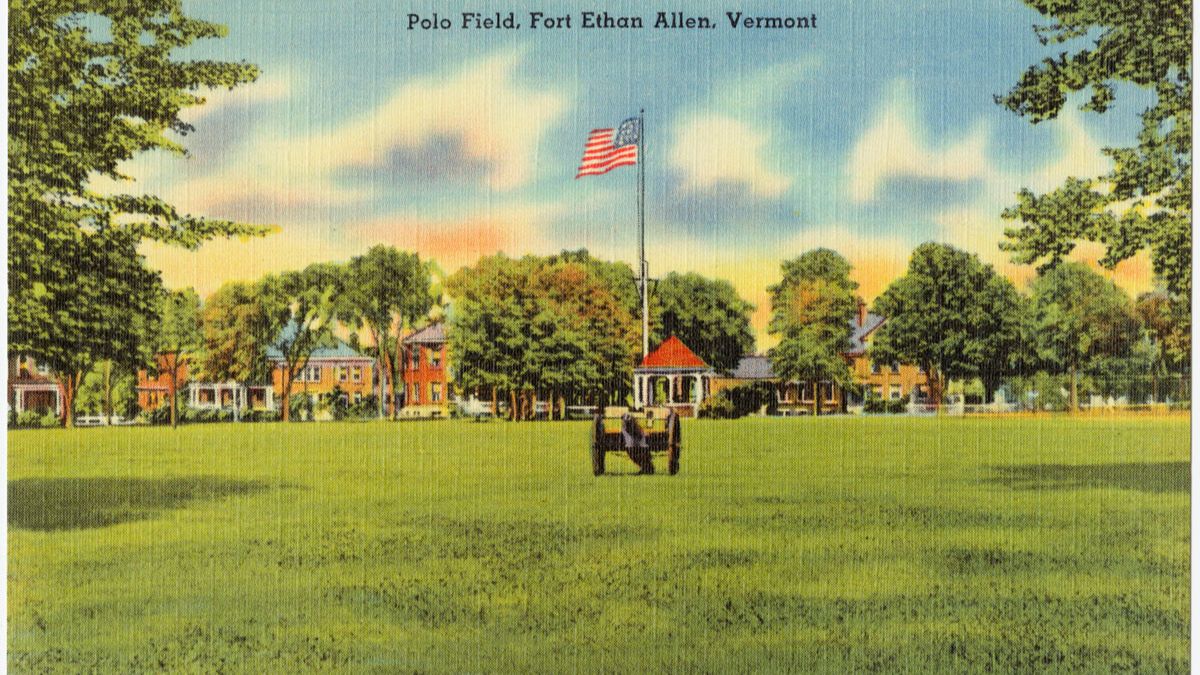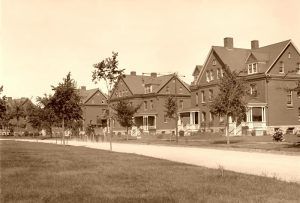
Echoes of the Cavalry: The Enduring Legacy and Transformation of Fort Ethan Allen
In the heart of Vermont, nestled between the vibrant city of Burlington and the quieter town of Colchester, lies a place where the echoes of thundering hooves still seem to whisper on the wind. Fort Ethan Allen, once a formidable military outpost, a bastion of the U.S. Cavalry, and a crucial training ground during two World Wars, has undergone a remarkable transformation. Today, it stands not as a relic of the past, but as a dynamic, thriving community – a living testament to adaptive reuse, where historic brick barracks now house college students and businesses, and former parade grounds host neighborhood gatherings.
Established in 1894, Fort Ethan Allen was born out of a period of rapid military expansion and evolving national defense strategies. Named after the legendary Revolutionary War hero and leader of the Green Mountain Boys, Ethan Allen, the fort was strategically located to serve as a permanent cantonment for cavalry and artillery units. Its construction, a significant undertaking for the relatively rural state, involved a substantial investment in infrastructure, including stately brick barracks, officer’s quarters, a hospital, a gymnasium, stables, and extensive parade grounds. The fort was designed to be self-sufficient, a small city within itself, capable of housing and training thousands of soldiers and their mounts.
The Golden Age of the Horse Soldier

The early decades of Fort Ethan Allen were its golden age, defined by the rhythmic clang of horseshoes on pavement, the distinctive smell of leather and hay, and the disciplined maneuvers of mounted troops. It quickly became known as a premier cavalry post, attracting some of the nation’s finest horsemen. The sight of squadrons of cavalrymen, resplendent in their uniforms, drilling across the sprawling parade ground or practicing charges, was a common spectacle, drawing crowds from Burlington and beyond.
One of the most fascinating aspects of Fort Ethan Allen’s history is its distinction as one of the last active cavalry posts in the United States. While other forts began mechanizing, Fort Ethan Allen held onto its equestrian traditions well into the 20th century. "For decades, this was the place where the horse soldier truly lived and breathed," notes Sarah Jenkins, a local historian with a particular interest in the fort’s military past. "The skills honed here – horsemanship, tactical deployment, endurance – were vital for an army that still relied heavily on horses for reconnaissance, skirmishing, and transport, especially in rugged terrain."
The fort played a crucial role in various military engagements. During the Spanish-American War, troops from Fort Ethan Allen were deployed to Cuba. Later, its cavalry units were instrumental in patrolling the U.S.-Mexico border during the Mexican Revolution. It was also a vital training center during World War I, preparing thousands of soldiers for deployment to the European front, though by this time, many were transitioning from horse-mounted combat to infantry and early mechanized warfare. Even a young George S. Patton, a future legendary general known for his love of cavalry, is said to have had early career connections to the training methodologies and ethos that defined posts like Fort Ethan Allen.
Life at the fort was rigorous but also fostered a strong sense of community. Soldiers engaged in daily drills, target practice, and physical training. Off-duty, they had access to amenities like the gymnasium, library, and social clubs. The presence of the fort also had a profound impact on the local economy and culture, creating jobs, stimulating trade, and integrating military families into the Vermont landscape. The sounds of bugle calls and the sight of soldiers marching or riding through town became an integral part of local life.
World War II and the Shifting Tides
As the world hurtled towards World War II, the role of Fort Ethan Allen evolved dramatically. The age of the horse soldier had largely passed, replaced by tanks, jeeps, and motorized transport. The fort was decommissioned as a permanent cavalry post in 1944, marking the official end of an era. However, its strategic location and extensive infrastructure made it invaluable for other purposes.
During World War II, Fort Ethan Allen was repurposed as a major induction and training center. Thousands of recruits from across New England passed through its gates, receiving their initial military training before being deployed overseas. It also served as a processing center for returning soldiers and, for a brief period, as a prisoner-of-war camp for German and Italian combatants. The fort’s population swelled, transforming its peaceful, equestrian character into a bustling hub of wartime activity. The iconic brick buildings, once home to cavalry troops, now housed a diverse array of soldiers preparing for a global conflict.
The end of World War II brought uncertainty to Fort Ethan Allen. With the immediate need for a large military presence diminished, the U.S. Army officially closed the fort in 1946. Its future was unclear. A sprawling complex of historic buildings, once a symbol of national defense, lay vacant, at risk of decay or demolition. Many such military bases across the country faced similar fates, becoming ghost towns or being razed for new development. But Fort Ethan Allen was destined for a different path.

A Masterclass in Adaptive Reuse: From Barracks to Classrooms and Homes
The post-military chapter of Fort Ethan Allen is a remarkable story of vision, community effort, and adaptive reuse. In the years following its closure, the sprawling property was gradually sold off and repurposed, piece by piece, into a vibrant, mixed-use community that brilliantly preserved its historic character while embracing modern needs.
One of the most significant transformations came with the establishment of Champlain College’s Lakeside Campus. Recognizing the unique architectural heritage and spacious grounds, the college began acquiring parcels of the former fort in the mid-20th century. Today, many of the original barracks, officer’s quarters, and administrative buildings have been meticulously renovated and transformed into dormitories, classrooms, and administrative offices. The former parade ground, once a stage for cavalry drills, now serves as an expansive lawn for student recreation and campus events. This integration has breathed new life into the historic structures, ensuring their continued relevance and maintenance.
Beyond Champlain College, other institutions and businesses found a home within the fort’s boundaries. The Vermont National Guard maintains a significant presence, utilizing some of the original buildings and newly constructed facilities for its operations, thus continuing a military connection to the site. Various state agencies, non-profits, and private businesses have also moved into the renovated spaces, creating a diverse economic ecosystem.
Perhaps most notably, Fort Ethan Allen has become a cherished residential community. Many of the former officer’s quarters and other smaller buildings have been converted into single-family homes, while new residential developments have been carefully integrated into the existing layout. The result is a unique neighborhood characterized by its historic architecture, tree-lined streets, and a palpable sense of history. "Living here is like being part of a living museum," says Eleanor Vance, a resident who has called the fort home for over two decades. "You walk down the street, and you can almost hear the horses, but then you see kids playing on the old parade ground, and it’s clear this place is very much alive."
Preserving the Past, Building the Future
The successful transformation of Fort Ethan Allen is a testament to careful planning and a deep appreciation for its heritage. The entire Fort Ethan Allen Historic District was listed on the National Register of Historic Places in 1986, a crucial step that provided protections and incentives for preservation. Efforts have focused on maintaining the architectural integrity of the original brick buildings, many of which feature distinctive Romanesque Revival and Colonial Revival elements. The layout of the fort, with its central parade ground and orderly arrangement of buildings, remains largely intact, allowing visitors and residents to visualize its military past.
The enduring legacy of Fort Ethan Allen is multifaceted. It represents a significant chapter in American military history, particularly the era of the U.S. Cavalry. It stands as a powerful example of how historic infrastructure can be reimagined and repurposed to meet contemporary needs, offering a sustainable model for urban and community development. It is a place where the past informs the present, where the echoes of military might have given way to the vibrant hum of education, commerce, and community life.
From the thunder of hooves to the quiet footsteps of students, from the rigors of military training to the comfort of modern homes, Fort Ethan Allen has navigated a profound journey. It is more than just a collection of old buildings; it is a dynamic, evolving landscape that proudly wears its history while embracing its future. For those who walk its streets, whether they are students rushing to class, residents tending their gardens, or history enthusiasts exploring its past, Fort Ethan Allen serves as a powerful reminder that even the most formidable structures can find new purpose, ensuring that the legacy of the horse soldier, and the spirit of Ethan Allen himself, continues to inspire and endure.


